Framing Statement
#NoFilter
Starting with the inspiration of Venus, the Roman goddess of love, beauty and fertility, we have created a performance that explores the struggles that women face to achieve perfection. In our exploration of women in art throughout the decades, we have discovered a clear reflection on how women are seen in today’s modern media; women are often seen as limited and unrealistic; depictions of women as domestic housewives, parents, sex objects and dependents upon men. There is also a very noticeable theme that is missing or under-depicted, working women. We are ‘exploring [the] physical and mental limits in the works that ritualize the simple actions of everyday life’ (Lisson Gallery, 2015) as a woman, using Marina Abramovic’s concept of allowing her body to be exposed to pain. We have taken influence from our own perspective of what challenges we, as women face, and the process we force ourselves to go through. Our performance highlights the ugliness behind the beauty.
With special thanks to:
Ferenc Igali, Darren Page and Ashley Gallant.
WARNING NOTE: This performance contains semi-nudity, sharp objects and potential allergy hazards (cosmetics and flowers)
We presented our framing text on an airer to correspond with our performative movement of putting the washing out.
Marketing Text
Throughout time artworks have been created which focus on the female body. From the image of Venus in art through to the representation of women in the modern media, the ideal version of the perfect woman has varied. Women have been portrayed in a way that their societies expected them to. This is prominent when studying the history of the illustration of women, as it often accentuates their assets through the visual perspective of the male. Through physicality and performative text, our performance explores the expectations of women and the struggle to achieve physical perfection.
This is a durational performance starting at 12 and finishing at 2. Please feel free to come and experience for as long as you like.
WARNING NOTE: This performance contains semi-nudity, sharp objects and potential allergy hazards (cosmetics and flowers)
Understanding Site-Specific Performance
Teaching/Archaeology- Mike Pearson and Micheal Shanks.
In this reading Pearson and Shanks present to us the comparisons between theatre and archaeology. ‘Performance and archaeology are social practices, or modes of cultural production,’ (Pearson, Shanks, 2001, p. 53) within this they are both connected to art, and create art forms which attract spectators through the sensorium produced by them. Neither performance nor archaeology would have been created without the fragments that were preserved for our history and of us as spectators to enjoy and experience. From these fragments we learn how important documentation is for both performance and archaeology as other generations can gain knowledge about our history. The most interesting comparison Pearson and Shanks drew upon was ‘social actors are as much as artefact as any other material cultural form’ (Pearson, Shanks, 2001, p. 54) due to the history performance can contain and how the actors portray this history.
John Berger/ Ways of Seeing (1972)
Episode 1
Paintings are representations of what the artist sees and how he portrays reality that is within the painting. Paintings are therefore the artists’ perspective. A photograph is what the world sees and wants to see. This cannot be opened to representation like a painting can; however paintings are more intimate due to it being the artists’ portrayal on reality. The artist also chooses what to paint and where to paint, which gives it more of a meaning with having a specific place and specific painting. This creates an uniqueness for the place and painting which you cannot experience anywhere else.
Episode 2
There is a clear difference between nude and naked. Naked is more personal and informal, whereas nude, is more of a form of art and a performance. When thinking about art and the portrayal of nude women within paintings, they seems relaxed and confident, maybe coming across as vain due to her looking at the spectator or herself. When thinking about the male spectator, this portrayal of women could be what they want to see and enjoy to see.
Blast Theory – An Example of Site- Specific Performance
One of Blast Theory’s earliest performances was Invisible Bullets in 1997. The performance surrounded a murder taking place which was re-enacted a number of times in many different styles. These styles ranged from a pop video, parody and to the performers wearing just underwear etc. The re-enactments were performed over 12 hours where the audience could come and go. Blast Theory used an unused pedestrian prescient and transformed the space into a viewing site for this performance. Although in an unusual setting the audience was set up in an average seating arrangement, this may be due to health and safety restrictions. Due to this seating arrangement there is an obvious divide between audience and performer which is unfamiliar in most other Blast Theory performances for example GhostWriter.
GhostWriter was conducted in 2011 at the Royal Albert Memorial Museum. The participants phoned a phone number which lead them to a recording of woman describing, questioning and telling them stories of art work and artefacts within the museum. The woman’s voice lead the participants around the space and encouraged them to explore more of the museum than they would have normally. In this performance there is irony as they are using something so present like technology to explore our past. It also breaks the conventions of a normal performance with the ‘audience’ actually being participants and being the focus within the performance.
Both performances are documented through Blast Theory’s websites and videos that are also accessible through their website.
Analysis of Process
Entering The Usher Gallery and The Collection
When starting our performance process we originally planned an idea to perform within The Collection, however that idea fell through and we needed to rethink. One thing that drew us to The Usher Gallery was the way women were presented within the gallery; they were objectified and seen as sexualised images. As well as this we noticed how most artwork of the female was not created by women, they were created by men. This sparked a passion within each of us and we decided to create a performance that challenges the way women are presented in art and society.
Marina Abramovic
We were introduced to Marina Abramovic when watching a documentary on her work The Artist is Present. One thing noted with Abramovic’s performances is that she uses her body as an instillation for people to engage with. As a group we found inspiration with that idea and decided to create a powerful performance we should exhibit ourselves. In her work Rhythm O, Abramovic placed 72 objects for the spectator to use on her body to inflict pain and pleasure, which lead to the final image of her having a gun pointing to her head crying. From this we thought of showing how objects can physically and psychologically inflict pain on us. Since Abramovic deals with ‘true reality, [that is] often at great physical and psychological cost’ (O’Hagan, 2010) we wanted to feel this for us to really express what we wanted to show.
(Rubrica di Arte, 2013)
Another influence…
Drawing inspiration from Laura Mulvey’s Visual Pleasure and Narrative Cinema where she talks about scopaphila (pleasure in looking) how the ‘woman stands in patriarchal culture as a signifier for the male other, bound by a symbolic order in which man can live out his fantasies and obsessions’ (Mulvey, 1975) by them being ‘simultaneously looked at and displayed, with their appearance coded for strong visual and erotic impact.’ (Mulvey, 1975) We want to challenge that within the gallery due to most of the artwork of women are created by male artists, therefore restricting women to the view of the male gaze. We will centre the performance around the statue of Venus and cupid due to her being a female symbol of love, beauty, sex, fertility, prosperity and desire.
Discovering
When having the main concept we wanted to explore, we wanted to try out some of the ideas we had:
1. Taking the pose of the Venus statue, we would place one single object where cupid would be on our face. By doing this we noticed how it distorted our image and vocals as well as the pain we were experiencing when holding up the object. We thought it would have created quite a powerful image on how an object of beauty can distort what we see and say, however due to our voices being unclear and the noise from the humidifier it was just being lost.
2. We all liked the use of the objects and the significance they had, so we thought about collecting items of our own that makes us the women we are. With the objects we thought about attaching them to string and restraining ourselves with it.
As you can see it looks incredibly messy and did not make such an impact as we hoped.
3.From the pervious idea we developed something integrating the use of our personal objects and the string.
The idea
We wanted to create a performance that provoked questions on why we as women go through our daily routines to try and achieve perfection. Over a couple of weeks we collected our personal objects that signify us as women and placed them in transparent bags (inventory below). Using our bodies, three of us will form a triangle connected by string to symbolise a washing line. The other will have the bags of objects and will attach them by pegs as if she is putting the washing out. We wanted to combine a domestic chore with the desire to be beautiful since the mixture of both domestic and beauty can be seen as the ‘perfect’ woman. Whilst the action of hanging the objects up is conducted, the three bodies will be take four poses that shows the strain and suppression that these objects have on us as women. By the act of another female putting this stress on us, we wanted to show that this commonly does happen in society today as well as us choosing to inflict ourselves with these pressures.
(Kotsopoulou, 2015)
Performative text
Both museums and galleries are ‘presented as a performative site where its dominant socially and historically constructed pedagogy engages in a critical dialogue with the viewer’s memories and cultural histories’ (Garoian, 2001). With this in mind the text is created by snippets of our own poetry and classical poetry about women. Each poem was based on, or taken from a different period of time to show the change in the pressures women face to achieve perfection during the eras.
The final audio was overlapped to create a more distorted sound.
Inventory of objects
Nail polish remover
Foundation bottle
Loose hair
Nails
Used make up wipes
Used condoms
Small chocolates
Dead flower petals
Gym shoe
Ear buds
Hair grips
Chewing gum packet
Hard wax
Sanitary wrapping
Use cotton pads
Razors
Waxing spatula
Cleansing wipes packet
Femfresh packet
Dry skin
Blood smeared wet wipe
Contraceptive pill packet
Lipstick stained tissue
Lint roller
Perfume box
Used trainer socks
Bottle of tea tree night lotion
Bottle of tea tree clearing lotion
Bootea 14 day daytime detox
Bootea 14 night-time detox
Used tampon packets
Bottle of self-tanning lotion
Pair of laddered tights
Chocolate wrappers
Tanning buffer
Blood stained tissue
Used waxing strips
Jewellery
Challenges faced
Working in a museum and gallery came with a lot of restrictions due to preservation of art and artefacts. Because of the nature of us using our own items, e.g. cosmetics we needed to insure they were packaged safely so they would not harm the art work. Along with these restrictions came health and safely for us and the audience. We as a group collect all the possibilities of accidents happening and composed our own risk assessment.
LINCOLN UNIVERSITY – PERFORMING ARTS CENTRE (LPAC & LSPA) RISK ASSESSMENT FORM FOR LSPA SUDENT PERFORMANCES & ASSESSMENT PRODUCTIONS IN MAIN HOUSE STUDIOS CAMPUS AND OFFCAMPUS
PRODUCTION: #NoFilter DATE: 29/04/2015 VENUE/S: The Usher Gallery
| IDENTIFY HAZARD | WHO MIGHT BE HARMED | RISK | LIST ANY CONTROLS | ADDITIONAL CONTROL | ACTIONED | DATE |
| Cabling | Spectator, performer and artwork | H | Cabling is kept out of the way of aisles and walkways | |||
| Moving around objects | Performers, spectators and artwork | M | Ensure that all objects are moved around responsibly and safe manner | |||
| Sharp object within bag (razors) | Spectators and performers | M | Secured in a plastic see through bag. Controlled by performer(s). | Protective layer on object | ||
|
Heeled shoes
|
Performers, spectators, artwork |
M |
Choreographed movements and slow paced to reduce risk. | Practiced performance with shoes | ||
|
String
|
Spectator, artwork and performer |
L |
Positioning of performers lowers the risk of damaging the art. | |||
|
Dead petals in a bag
|
Spectator |
M |
Someone may suffer with hay fever or allergies | |||
| Bag falling off the string during performance | Artwork, spectator and performer | H | All objects in the bags are sealed properly | |||
| Performers movements | Spectator, artwork and performer(s) | M | Choreographed and paced movement to ensure that performers will not accidentally strike spectators or artwork | |||
| Semi – Nudity | Audience | L | Signs before the audience walk in to make them aware what they will come into contact with. |
UNIT COORDINATOR:
COMPLETED BY: Chloe Nugent, Emma Louise Kinsey, Jessica Carter and Winona Makanji.
Rehearsing in The Usher Gallery
Rehearsing within the site helped us to get used to the spacing we had to work with as well as training our bodies. Whilst rehearsing it was interesting to note the reaction we received from the spectators. We had a lot of women who saw us, had a quick look at the items and looked away, some women ignored us totally. This was interesting because our performance was about being a woman and the majority of women left without even acknowledging us. One of our last rehearsals before the performance we had 4 people interact with us, questioning what we were doing and finding it interesting; 3 were woman and the other was a man. We also had a large group of boys mimicking the poses we held and laughing. This could mean two things, they thought what we were doing was humorous, or they were intrigued to see how it felt to hold our positions. During a full run there was one woman who ignored us until she made eye contact with me and gave me a sympathetic smile and left. The differences between these reactions were interesting and made us more intrigued to see what we will receive in our final performance, especially when in our costume.
Costume
When thinking about what to wear for our performance, we originally thought about leotards in a stone colour to present ourselves as a statue like Venus. The issue with this was when wearing leotards people assume we will be dancing which we were not doing. In addition to this we decided a leotard would not connect to the context of our performance. We wanted to choose the appropriate costume that correlates with the idea of women trying to feel and look beautiful. From this we agreed control underwear and high heels would be more relevant. We bought a maximise bra (gives you double the cup size) and control pants to fit with the common social idea that large breasts and being skinny is attractive.
(Kotsopoulou, 2015)
The End Is In ‘Site’- Final Performance
We started by entering the room in a state of concentration so we can prepare ourselves for what we were just about to go through. We needed to be in a different state of mind to see through the pain and make it through the whole 2 hours of our performance. Throughout the performance we all began to feel the strain of holding our arms up (bending down for Jess). This pain was prominent on our faces but added to our performance as we were honestly feeling and not faking. As a spectator watching I can imagine it being quite difficult to watch, however this uncomfortable feeling they might have experienced is the reaction we wanted. This pain was not only felt throughout it impacted our bodies days after. For me I still had the indents on my wrist and a great pain in my shoulder, this was evidence of the extreme strain we put on ourselves.
(Kotsopoulou, 2015)
Whilst in the depths of our performance I noticed that a mixture of people stopped and watched us perform, there was a group of school girls, a family with young children, elderly couple and an elderly woman. This came as a surprise to us because we initially thought that we might have come across more provocative due to what we were dressed in and therefore would be ignored completely. The reason for them stopping and watching was maybe due to our set up being more obvious that a performance is taking place, or they were genuinely engaged with our performance.
When thinking of the performance as whole, firstly we were very pleased with ourselves for keeping our stamina strong throughout, and secondly we were intrigued by how many people spectated our performance. I believe our distorted audio was effective but may have been lost slightly, however if we were to do the performance again I would use stronger speakers to enhance the audio and give it more power. The overall look of our performance came across professional and powerful, and presented the truth that there is an ugly side to beauty.

(Kotsopoulou, 2015)
Documentation
Our documentation consisted of our inventory of the objects, the objects themselves and medicine pots filled with fragments of each object.
Bibliography/ Works cited
Blast Theory (2015) Ghostwriter [online] Available from http://www.blasttheory.co.uk/projects/ghostwriter/ [Accessed 8 February 2015]
Blast Theory (2015) Invisible Bullets – Video. [online] Available from http://www.blasttheory.co.uk/projects/invisible-bullets-video/ [Accessed 8 February 2015]
Garoian, C, R. (2001) Performing the Museum. Studies in Art Education, 42 (3) 234.
Kotsopoulou F. (2015) Site-Specific Performance- Performing the Gallery.
Lisson Gallery (2015) Marina Abramović. [Online] Available from http://www.lissongallery.com/artists/marina-abramovic [Accessed 4 May 2015].
Miscellaneous sounds from Youtube.
O’Hagan, S. (2010) Interview: Marina Abramović. [online] London: The Guardian. Available from http://www.theguardian.com/artanddesign/2010/oct/03/interview-marina-abramovic-performance-artist
Pearson, P. and Michael, S. (2001) Theatre/ Archaeology. London: Routledge.
Pearson, M. (2010) Site-specific performance. Houndmills. Baskingstoke, Hampshire: Palgrave Macmillian
Rubrica di Arte, (2013) Rhythm 0 – Marina and her audience.
tw1975(2012) John Berger/ Ways of Seeing (1972) [online video] Available from https://www.youtube.com/watch?v=0pDE4VX_9Kk [Accessed 30 January 2015]
tw1975(2012) John Berger/ Ways of Seeing (1972) [online video] Available from https://www.youtube.com/watch?v=m1GI8mNU5Sg [Accessed 30 January 2015]
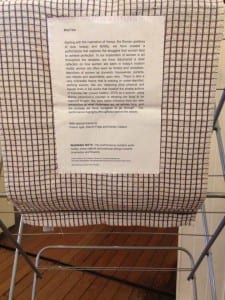
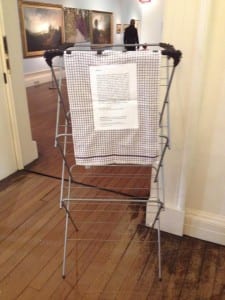

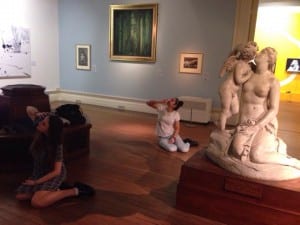
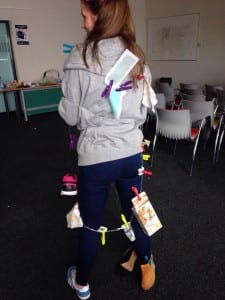
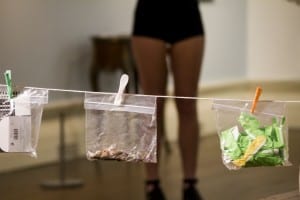
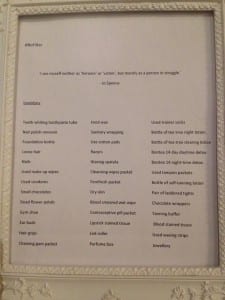
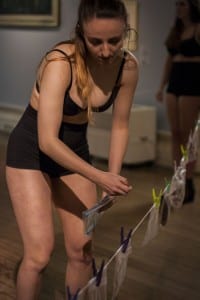


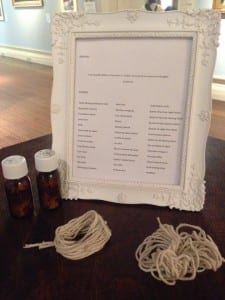

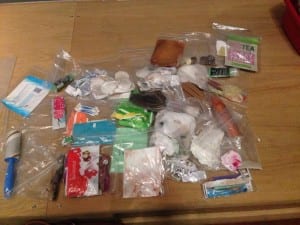
Recent Comments